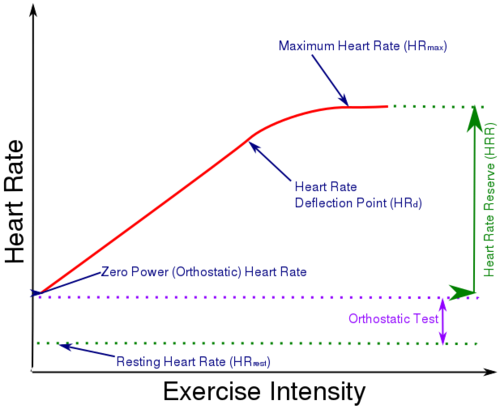Heart Rate Deflection

The heart rate deflection point is a controversial way of establishing an athlete's Lactate Threshold (LT), sometimes called the Anaerobic Threshold (AT). The Lactate Threshold is where the body starts to rely more on producing energy anaerobically (literally without oxygen) rather than aerobically (literally with oxygen). Heart rate is generally considered to be linear with effort (power output) up to about 80% of Maximum Heart Rate[1]. The best way of measuring the Lactate Threshold is to take a MLSS test, but this requires the analysis of blood samples. This is obviously invasive, inconvenient, painful and somewhat expensive. In 1980, Italian sport scientist and medical doctor Francesco Conconi developed a test procedure for establishing an athlete Lactate Threshold based on heart rate. The idea behind the test is to have the athlete exercise of gradually increasing intensity while recording their heart rate. When the athlete starts to produce energy anaerobically, their heart rate will not go up proportionate to the intensity. This change from linear relationship between heart rate and intensity is called the Heart Rate Deflection (HRd).
Contents
[hide]1 The Conconi Test
The Conconi test was described in a 1982 paper[2] and refined in 1996[3]. The original test is performed on a 400 m track with a heart rate monitor that will record the test. After a thorough warm-up, the athlete should run at a comfortable pace for 200m, and then increase their pace slightly at each subsequent 200 m. Is the time to cover each 200 m segment needs to be recorded, and this can be done by hitting the lap button on the heart rate monitor. The original Conconi test called for the athlete to increase their pace by 0.5 Km/hr, which is remarkably tricky. A modified test has the athlete increasing the pace by 2 seconds per 200 m interval. The test continues until the athlete can no longer runs of the required pace. The 1996 test changed the protocol to increase the pace in a more uniform rather than using steps, and changed to time rather than distance, with increases every 30 seconds.
2 Validity of the Conconi test
The Conconi test is remarkably controversial, with many potential issues[4].
- There is relatively little scientific support that actually validates the blood lactate levels in comparison to the HRd. Conconi's original work compared blood lactate levels at speeds above and below those seen as HRd, but the comparisons were performed on separate occasions.
- It is difficult for runners to increase their pace by precise amount and then hold that pace for a given distance.
- The changes in heart rate between each segment may be quite small.
- In many instances the HRd is difficult to identify or completely absent.
- Some studies have observed the when the HRd is discernible it can occur well above anaerobic threshold, creating a risk of overtraining.
- At higher intensities, HR may not reach a steady state, making the deflection hard to detect.
- Other studies have shown a disassociation between HRd and the anaerobic threshold.
These concerns and issues make the usefulness of the Conconi test unclear. Personally I would suggest that it is better to either use training paces based on race performance (Jack Daniels Running Formula), or actually measure blood lactate directly.
3 Directly Measuring Lactate Threshold
It is possible to measure the lactate level in the blood using a device similar to a blood glucose meter[5]. Just like a blood glucose meter, a small drop of blood must be drawn and applied to a disposable test strip. This process is rather tricky when exercising at high intensity, and stopping to draw blood will obviously interfere with the exercise level. Lactate meters cost $300-500, with this test strips costing around $2/each.
4 References
- Jump up ↑ Daniel Meyer, Carolin Dungs, Veit Senner, Estimating the Relationship between Heart Rate and Power Output for Short Term Cycling Exercises, Procedia Engineering, volume 112, 2015, pages 237–243, ISSN 18777058, doi 10.1016/j.proeng.2015.07.206
- Jump up ↑ F. Conconi, M. Ferrari, PG. Ziglio, P. Droghetti, L. Codeca, Determination of the anaerobic threshold by a noninvasive field test in runners., J Appl Physiol Respir Environ Exerc Physiol, volume 52, issue 4, pages 869-73, Apr 1982, PMID 7085420
- Jump up ↑ F. Conconi, G. Grazzi, I. Casoni, C. Guglielmini, C. Borsetto, E. Ballarin, G. Mazzoni, M. Patracchini, F. Manfredini, The Conconi test: methodology after 12 years of application., Int J Sports Med, volume 17, issue 7, pages 509-19, Oct 1996, doi 10.1055/s-2007-972887, PMID 8912066
- Jump up ↑ I Cook, Was the Conconi test validated by sporting success, expert opinion or good science?, South African Journal for Research in Sport, Physical Education and Recreation, volume 33, issue 1, 2011, ISSN 0379-9069, doi 10.4314/sajrs.v33i1.65483
- Jump up ↑ RK. Tanner, KL. Fuller, ML. Ross, Evaluation of three portable blood lactate analysers: Lactate Pro, Lactate Scout and Lactate Plus., Eur J Appl Physiol, volume 109, issue 3, pages 551-9, Jun 2010, doi 10.1007/s00421-010-1379-9, PMID 20145946